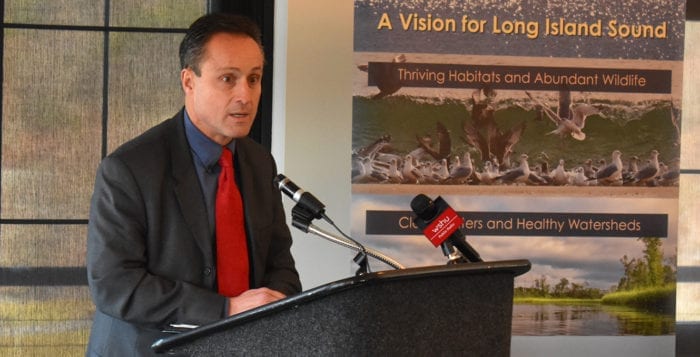LI environmental groups receive funds to heal Sound

Local environmental groups are anticipating expanding Long Island Sound education and cleanup initiatives, thanks to both state and federal funds.
As part of the 14th annual National Fish and Wildlife Foundation’s Long Island Sound Futures Fund initiative, federal and New York State officials announced Dec. 3 that 36 new grants totaling $2.57 million will go to environmental groups in Connecticut and New York, and $586,000 of those funds will benefit New York organizations.
“The funding is seed money investment for launching additional resources, pulling people together and bringing people together in conversation,” said Pete Lopez, the regional administrator for the U.S. Environmental Protection Agency.

Lynn Dwyer, the program director of the fund, said the projects were selected by an unbiased, unaffiliated group of environmental experts. The money is reaching these groups as experts say the marine life in the sound has come under threat. In September the Long Island Clean Water Partnership, an advocacy collective supported by the Rauch Foundation, released its yearly report that showed dangerous amounts of poisonous algae blooms in coastal regions from Port Jefferson Harbor to Huntington Harbor. In addition, more and more areas are expressing hypoxia, or a lack of oxygen in water necessary to support marine life. Experts in the partnership said both of these are due to excess amounts of nitrogen in the water, mostly due to aging septic tanks and cesspools all across Long Island.
Several of the projects center on beach cleanup and environmental stewardship. The North Fork-based nonprofit Group for the East End will be receiving $67,542 to remove invasive plants and develop habitat restoration plans for the Hallock State Park Preserve in Riverhead.
Environmental advocacy group Citizens Campaign for the Environment received $45,000 in grants to conduct a public education campaign to reduce plastic pollution on local beaches in both Nassau and Suffolk counties. Adrienne Esposito, the director of CCE, said the project will gather 500 pledges to reduce throw-away plastic use and engage close to 200 volunteers in coastal cleanups on beaches across the North Shore. The group will be adding an additional $45,000 in matching funds from its own funds for the project.
“We will be distributing reusable metal straws, so people can use those in place of plastic straws,” Esposito said.
In addition to the public education campaign, which will start in January 2019, she said the advocacy group is commissioning a local artist to build a giant metal wire-mesh turtle to be placed in Sunken Meadow State Park. The turtle will be filled with all the plastic debris the volunteers pick-up during their beach cleanup to be viewable by the public. Esposito said she expects the beach cleanup and mesh turtle to be done during summer 2019.
“These birds depend on our Long Island beaches to safely nest, rest, forage and raise their young without the threat of disturbance.” — Sharon Bruce
The New York chapter of the National Audubon Society is receiving $41,009 from the fund for its continuing Be a Good Egg environmental education program encouraging people to share the waterside with shorebirds. The society will be focusing its efforts on a number of beaches, including at Hallock State Park Preserve, Stony Brook Harbor and along Nissequogue River. Sharon Bruce, the communications manager for Audubon New York, said some of the birds they wish to protect include the piping plover, least tern and American oystercatcher, all of which nest directly on the sand.
“These birds depend on our Long Island beaches to safely nest, rest, forage and raise their young without the threat of disturbance,” Bruce said.
Other projects look to beautify and increase biodiversity in coastal areas. The Long Island Explorium, located in Port Jefferson Village, is receiving $43,626 in grant funds to install native plant rain gardens in high visibility areas such as in front of its building on East Broadway and the corner of East Broadway and Main Street.
“There’s a visual component to it and an educational component,” said Angeline Judex, Long Island Explorium executive director. “It will show to the 800,000 visitors to [Port Jefferson Village] how rain gardens improve the water quality of the harbor.”






